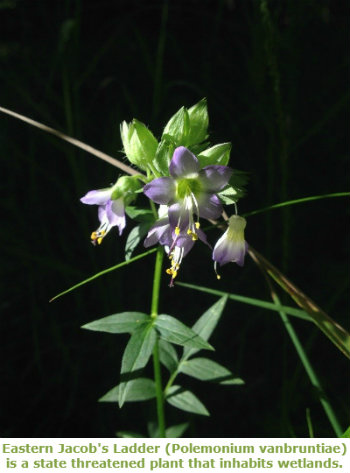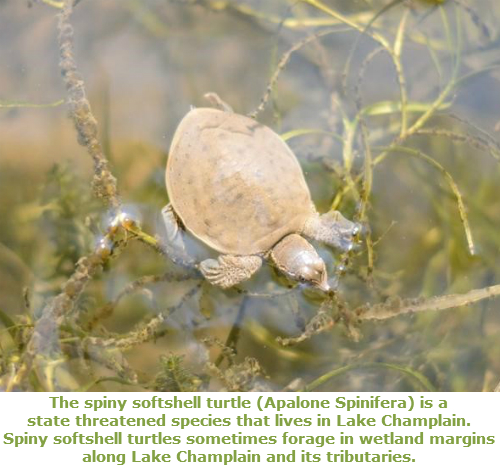 About 43% of the nation's endangered and threatened species rely directly or indirectly on wetlands for survival. Endangered species are species that, if not protected, are in imminent danger of permanently disappearing from Earth. Threatened species are species that, if not protected, are likely to become endangered in the foreseeable future. In 1973, Congress passed the Endangered Species Act with the express purpose of protecting species that were in danger of extinction. In Vermont, species with a state status of Threatened or Endangered are protected by the Vermont Endangered Species Law (10 V.S.A. Chap. 123). The Natural Heritage Inventory, administered by the Wildlife Diversity Program of the Vermont Department of Fish and Wildlife, is the state's official repository for records of rare, threatened, and endangered species.
About 43% of the nation's endangered and threatened species rely directly or indirectly on wetlands for survival. Endangered species are species that, if not protected, are in imminent danger of permanently disappearing from Earth. Threatened species are species that, if not protected, are likely to become endangered in the foreseeable future. In 1973, Congress passed the Endangered Species Act with the express purpose of protecting species that were in danger of extinction. In Vermont, species with a state status of Threatened or Endangered are protected by the Vermont Endangered Species Law (10 V.S.A. Chap. 123). The Natural Heritage Inventory, administered by the Wildlife Diversity Program of the Vermont Department of Fish and Wildlife, is the state's official repository for records of rare, threatened, and endangered species.

According to the Vermont Wetland Rules, wetlands that contain threatened or endangered species are significant wetlands. In determining whether a wetland is significant for the Threatened and Endangered Species Habitat function, the Secretary or Panel shall consider whether:
a. There is creditable documentation that the wetland provides important habitat for any species on the federal or state threatened or endangered species list of animals or plants.
b. There is creditable documentation that the wetland has contained one or more threatened or endangered species on the federal or state list in the past 10 years.
c. There is creditable documentation that the wetland provides important habitat for any species listed as rare in Vermont (S1 or S2 ranks), state historic (SH rank), or rare to uncommon globally (G1, G2, or G3 ranks), by the Nongame and Natural Heritage Program (Wildlife Diversity Program) of the Vermont Fish and Wildlife Department.
d. There is creditable documentation that the wetland provides habitat for multiple uncommon species of species of plants or animals (S3 rank).
Links of Interest
- Endangered Species Act of 1973: legislation that protects the ecosystems which endangered species and threatened species depend upon.
- Species Information: information and search engine for endangered and threatened species from the U.S. Fish and Wildlife Service
- Vermont Wildlife Diversity Program: The Wildlife Diversity Program is responsible for monitoring, managing, and conserving nongame wildlife (animals that are not fished or hunted). Special focus is given to the protection of endangered and threatened species, including listing, permitting, and drafting and implementing recovery plans. The Program includes the Natural Heritage Inventory, which documents the diversity of native plants, animals and natural communities in the state. The Natural Heritage Inventory maintains a robust spatial (GIS) database of species and natural community observations used in conservation and regulatory planning.
- Vermont's Rare and Uncommon Native Animals: a list compiled by the Vermont Nongame and Natural Heritage Program intended to inform naturalists, biologists, planners, developers and the general public about our rare native fauna, including state Threatened and Endangered species.
- Vermont's Rare and Uncommon Native Plants: a list compiled by the Vermont Nongame and Natural Heritage Program intended to inform naturalists, biologists, planners, developers and the general public about our rare native flora, including state Threatened and Endangered species.
- Ranking and Status: an explanation of the legal status and ranking of rare, threatened and species of special concern.
